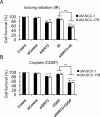Sirtuin-3 (SIRT3), a novel potential therapeutic target for oral cancer
- PMID: 21472714
- PMCID: PMC3117020
- DOI: 10.1002/cncr.25676
Sirtuin-3 (SIRT3), a novel potential therapeutic target for oral cancer
Abstract
Background: Several sirtuin family members (SIRT1-7), which are evolutionarily conserved NAD-dependent deacetylases, play an important role in carcinogenesis. However, their role in oral cancer has not yet been investigated. Therefore, the objective of this study was to investigate whether sirtuins play a role in oral cancer carcinogenesis.
Methods: The expression levels of all sirtuins in several oral squamous cell carcinoma (OSCC) cell lines were compared with normal human oral keratinocytes and observed that SIRT3 was highly expressed. Therefore, tissue microarrays were used to evaluate the clinical relevance of this overexpression. SIRT3 down-regulation in OSCC cell proliferation and survival was investigated and analyzed by using cell-proliferation and cell-viability assays. Ionizing radiation and cisplatin were used to investigate whether SIRT3 down-regulation could increase the sensitivity of OSCC to both treatments. To further assess the in vivo role of SIRT3 in OSCC carcinogenesis, a floor-of-mouth oral cancer murine model was used to study the effect of SIRT3 down-regulation on OSCC tumor growth in immunodeficient mice.
Results: The current results demonstrated for the first time that SIRT3 is overexpressed in OSCC in vitro and in vivo compared with other sirtuins. Down-regulation of SIRT3 inhibited OSCC cell growth and proliferation and increased OSCC cell sensitivity to radiation and cisplatin treatments in vitro. SIRT3 down-regulation also reduced tumor burden in vivo.
Conclusions: The current investigation revealed a novel role for SIRT3 in oral cancer carcinogenesis as a promoter of cell proliferation and survival, thus implicating SIRT3 as a new potential therapeutic target to treat oral cancer.
Copyright © 2010 American Cancer Society.
Figures





References
-
- Bsoul SA, Huber MA, Terezhalmy GT. Squamous cell carcinoma of the oral tissues: a comprehensive review for oral healthcare providers. J Contemp Dent Pract. 2005;6:1–16. - PubMed
-
- National Cancer Institute. Bethesda: Md: National Cancer Institute; 2009. Surveillance, Epidemiology, and End Results (SEER) Program. SEER Stat Fact Sheets: Oral Cavity and Pharynx. http://seer.cancer.gov/statfacts/html/oralcav.html?statfacts_page=oralca.... Accessed January 7, 2010.
-
- Saunders LR, Verdin E. Sirtuins: critical regulators at the crossroads between cancer and aging. Oncogene. 2007;26:5489–5504. - PubMed
-
- Haigis MC, Guarente LP. Mammalian sirtuins—emerging roles in physiology, aging, and calorie restriction. Genes Dev. 2006;20:2913–2921. - PubMed

